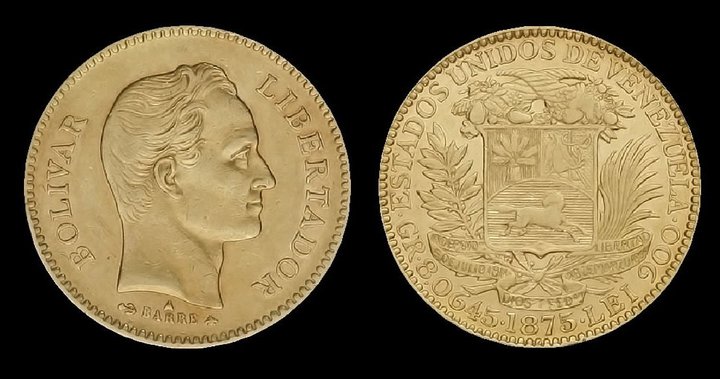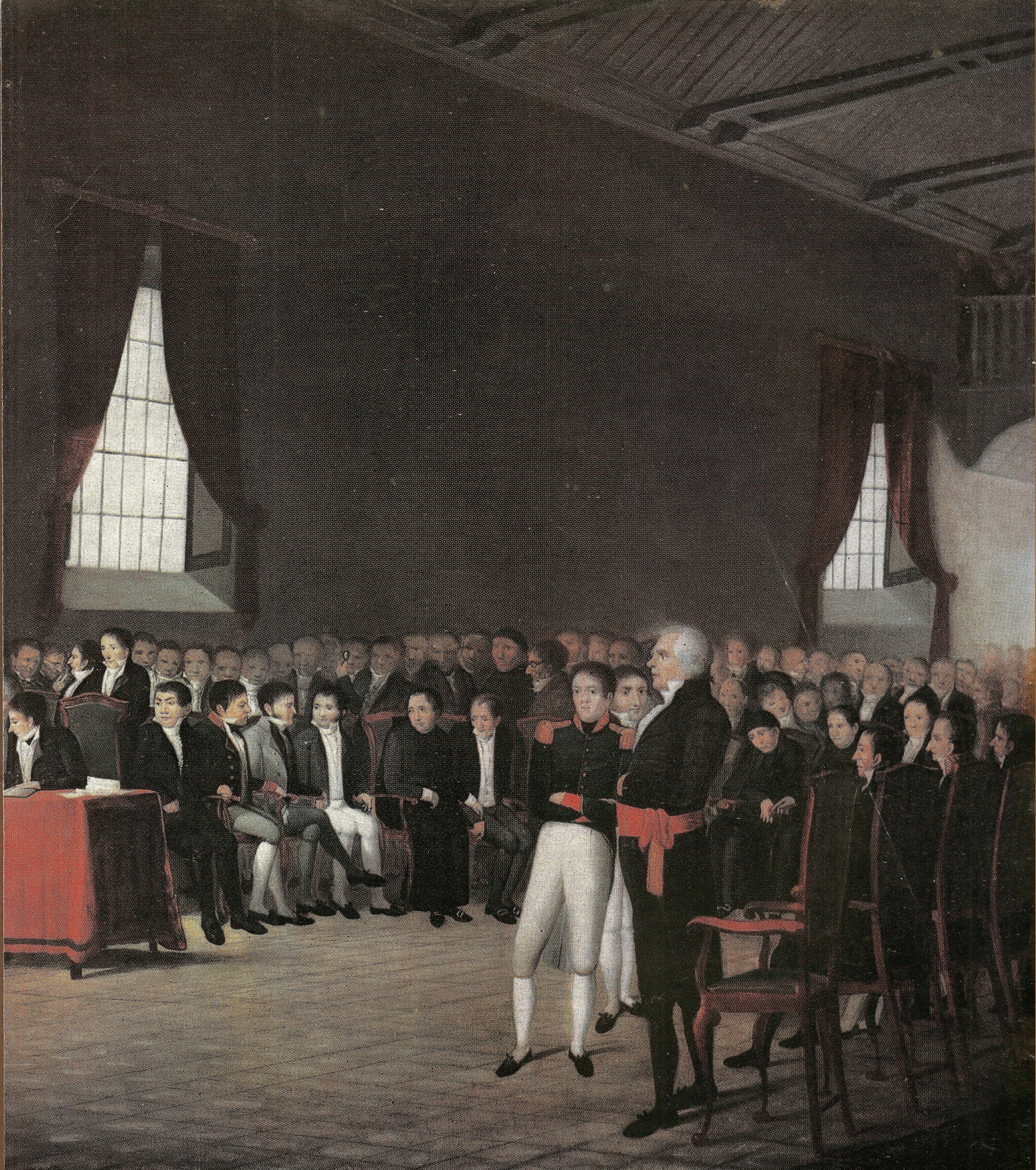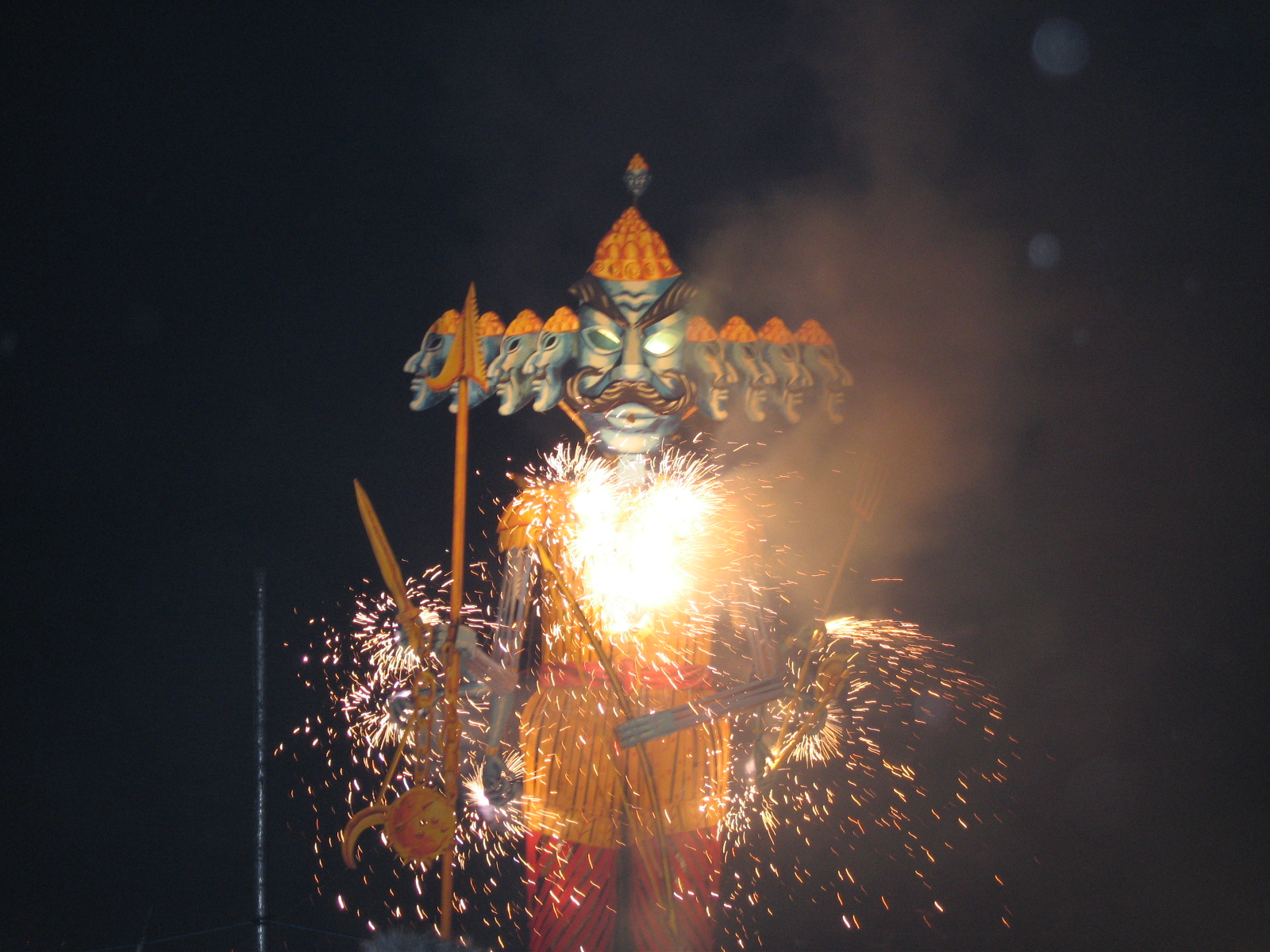|
Venezuelan Venezolano
The venezolano was the currency of Venezuela between 1872 and 1879. It was divided into 100 '' centavos'', although the names ''céntimo'' and ''centésimo'' were also used. Venezolano was also the name of two currencies planned in 1854 and 1865 (see Currency of Venezuela). History Given the inability of previous governments to order enough coins from the mints in Paris, London, and United States to meet demand, many foreign and demonetised coins circulated that were prone to perforations, scratches, chipping, or smoothing beyond recognition. The monetary law of 11 May 1871 replaced the peso (the only one of the coins in circulation that was legal tender) with the venezolano at par. Coins were minted by several banks including ''la Compañía de Crédito'' (lit. The Credit Company) and ''Estado de Guayana'' (lit. State of Guiana) following a pattern of copper, nickel, silver and gold. From 1 January 1872 all accounts had to be converted and expressed in venezolanos ... [...More Info...] [...Related Items...] OR: [Wikipedia] [Google] [Baidu] |
Venezuelan Peso
The peso (local name ''peso fuerte'') was a currency of Venezuela until 1874. History Until 1821, the Spanish colonial real circulated in Venezuela. Some of these coins were minted at the Caracas Royal Mint (Spanish: ''Real Casa de Moneda de Caracas'') established in 1802. Coins minted in Caracas were called Venezuelan reales. On 27 August 1811, with the United States of Venezuela (''Estados Unidos de Venezuela'') having declared their independence, the recently established Supreme Congress of Venezuela (''Congreso Supremo de Venezuela'') establishes the peso with an equivalence of 8 reales to 1 peso and an initial issue of one million pesos in paper money. Since no lower denominations or metallic coins had been issued; foreign, low-value coins circulated alongside the peso in Venezuela. In particular, with the establishment of the Colombian real in 1820 came its circulation in Venezuela the following year. Indeed, as part of Gran Colombia, the Caracas mint would issue Colombian ... [...More Info...] [...Related Items...] OR: [Wikipedia] [Google] [Baidu] |
Simon Bolívar
Simon may refer to: People * Simon (given name), including a list of people and fictional characters with the given name Simon * Simon (surname), including a list of people with the surname Simon * Eugène Simon, French naturalist and the genus authority ''Simon'' * Tribe of Simeon, one of the twelve tribes of Israel Places * Şimon ( hu, links=no, Simon), a village in Bran Commune, Braşov County, Romania * Șimon, a right tributary of the river Turcu in Romania Arts, entertainment, and media Films * ''Simon'' (1980 film), starring Alan Arkin * ''Simon'' (2004 film), Dutch drama directed by Eddy Terstall Games * ''Simon'' (game), a popular computer game * Simon Says, children's game Literature * ''Simon'' (Sutcliff novel), a children's historical novel written by Rosemary Sutcliff * Simon (Sand novel), an 1835 novel by George Sand * ''Simon Necronomicon'' (1977), a purported grimoire written by an unknown author, with an introduction by a man identified only as "Simon ... [...More Info...] [...Related Items...] OR: [Wikipedia] [Google] [Baidu] |
1872 Establishments In Venezuela
Year 187 ( CLXXXVII) was a common year starting on Sunday (link will display the full calendar) of the Julian calendar. At the time, it was known as the Year of the Consulship of Quintius and Aelianus (or, less frequently, year 940 '' Ab urbe condita''). The denomination 187 for this year has been used since the early medieval period, when the Anno Domini calendar era became the prevalent method in Europe for naming years. Events By place Roman Empire * Septimius Severus marries Julia Domna (age 17), a Syrian princess, at Lugdunum (modern-day Lyon). She is the youngest daughter of high-priest Julius Bassianus – a descendant of the Royal House of Emesa. Her elder sister is Julia Maesa. * Clodius Albinus defeats the Chatti, a highly organized German tribe that controlled the area that includes the Black Forest. By topic Religion * Olympianus succeeds Pertinax as bishop of Byzantium (until 198). Births * Cao Pi, Chinese emperor of the Cao Wei state (d. 226) * G ... [...More Info...] [...Related Items...] OR: [Wikipedia] [Google] [Baidu] |
Currencies Of Venezuela
A currency, "in circulation", from la, Wikt:currens, currens, -entis, literally meaning "running" or "traversing" is a standardization of money in any form, in use or currency in circulation, circulation as a medium of exchange, for example banknotes and coins. A more general definition is that a currency is a ''system of money'' in common use within a specific environment over time, especially for people in a nation state. Under this definition, Pound sterling, the British Pound Sterling (£), euros (€), Japanese yen (¥), and United States dollar, U.S. dollars (US$)) are examples of (government-issued) fiat currencies. Currencies may act as store of value , stores of value and be traded between nations in foreign exchange markets, which determine the relative values of the different currencies. Currencies in this sense are either chosen by users or decreed by governments, and each type has limited boundaries of acceptance - i.e. legal tender laws may require a particular uni ... [...More Info...] [...Related Items...] OR: [Wikipedia] [Google] [Baidu] |
Modern Obsolete Currencies
Modern may refer to: History * Modern history ** Early Modern period ** Late Modern period *** 18th century *** 19th century *** 20th century ** Contemporary history * Moderns, a faction of Freemasonry that existed in the 18th century Philosophy and sociology * Modernity, a loosely defined concept delineating a number of societal, economic and ideological features that contrast with "pre-modern" times or societies ** Late modernity Art * Modernism ** Modernist poetry * Modern art, a form of art * Modern dance, a dance form developed in the early 20th century * Modern architecture, a broad movement and period in architectural history * Modern music (other) Geography *Modra, a Slovak city, referred to in the German language as "Modern" Typography * Modern (typeface), a raster font packaged with Windows XP * Another name for the typeface classification known as Didone (typography) * Modern, a generic font family name for fixed-pitch serif and sans serif fonts (f ... [...More Info...] [...Related Items...] OR: [Wikipedia] [Google] [Baidu] |
History Of Venezuela
The history of Venezuela reflects events in areas of the Americas colonized by Spain starting 1522; amid resistance from indigenous peoples, led by Native caciques, such as Guaicaipuro and Tamanaco. However, in the Andean region of western Venezuela, complex Andean civilization of the Timoto-Cuica people flourished before European contact. In 1811, it became one of the first Spanish-American colonies to declare independence, which was not securely established until 1821, when Venezuela was a department of the federal republic of Gran Colombia. It gained full independence as a separate country in 1830. During the 19th century, Venezuela suffered political turmoil and autocracy, remaining dominated by regional ''caudillos'' (military strongmen) until the mid-20th century. Since 1958, the country has had a series of democratic governments. Economic shocks in the 1980s and 1990s led to several political crises, including the deadly Caracazo riots of 1989, two attempted coups in 199 ... [...More Info...] [...Related Items...] OR: [Wikipedia] [Google] [Baidu] |
Guayana Region
The Guayana Region is an administrative region of eastern Venezuela. History In the 1970s, after the process of forming the Political-Administrative Regions through CORDIPLAN in the government of Rafael Caldera, the Region of Guyana was formed. It was originally composed of Bolívar State and Delta Amacuro State (at that time it had the status of a Federal Territory). The Amazon state (called ''Territorio Federal Amazonas'') was the only one that made up the so-called ''Southern Region''. The following decade, after a legal reform, the latter state was integrated into this region. Geography The region has a population of 1,383,297 inhabitants and a territory of , slightly over half the area of the whole country. During the colonial period until the early 18th century, it was known as Spanish Guiana. It borders the independent nations of Guyana (formerly British Guiana) and Brazil. Geologically it is part of the Guiana Shield, and is also known as the Venezuelan Gua ... [...More Info...] [...Related Items...] OR: [Wikipedia] [Google] [Baidu] |
Ministry Of Popular Power For Communication And Information
The Ministry of Popular Power for Communication and Information (Minci) is a public ministry of the Government of Venezuela dedicated to communication, informing the Venezuelan public and promoting the Venezuelan government. Structure *Minister of Popular Power for Communication and Information *General Directorate Office *General Directorate of Presidential Communications *Vice Minister of Communication and Information *Vice Minister of Television *Vice Minister of Radio *Vice Minister of Print Media *Vice Minister of Social Networks Organs and Affiliated Entities Ministry *National Commission of Telecommunications * Bolivarian Communication and Information System Affiliated media organizations Affiliated media organizations include: Ministers Censorship The Institute Press and Society (Ipys) has criticized freedom of information and expression in Venezuela, though the Ministry of Popular Power for Communication and Information responded to these allegations by criticizing t ... [...More Info...] [...Related Items...] OR: [Wikipedia] [Google] [Baidu] |
Venezuelan Real
The real (plural: ''reales'') was the currency of Venezuela until 1843. History Until 1821, the Spanish colonial real circulated in Venezuela. On 12 June 1802, a mint was opened in Caracas and issued coins denominated in reales until 1821. Paper money was introduced in 1811 denominated in pesos. The Colombian real circulated in Venezuela from 1821, with some coins struck in Caracas. In 1837, the Colombian real was replaced by the Colombian peso (subdivided into 8 reales), which was itself replaced by the Venezuelan peso (subdivided into 10 reales) in 1842 (though it would take a year for the new coins to enter circulation, replacing the 1820s reales). The "real" moniker would continue to be used as a subdivision of the peso until 1863 when the last coin bearing "real" was struck. Coins From 1802, copper and real coins were issued. Silver 1 and 2 reales followed in 1810. In 1812, the Republican government issued copper and real and silver and 1 real. From 1813, the provinc ... [...More Info...] [...Related Items...] OR: [Wikipedia] [Google] [Baidu] |
Millesimal Fineness
The fineness of a precious metal object (coin, bar, jewelry, etc.) represents the weight of ''fine metal'' therein, in proportion to the total weight which includes alloying base metals and any impurities. Alloy metals are added to increase hardness and durability of coins and jewelry, alter colors, decrease the cost per weight, or avoid the cost of high-purity refinement. For example, copper is added to the precious metal silver to make a more durable alloy for use in coins, housewares and jewelry. Coin silver, which was used for making silver coins in the past, contains 90% silver and 10% copper, by mass. Sterling silver contains 92.5% silver and 7.5% of other metals, usually copper, by mass. Various ways of expressing fineness have been used and two remain in common use: ''millesimal fineness'' expressed in units of parts per 1,000 and '' karats'' or ''carats'' used only for gold. Karats measure the parts per 24, so that 18 karat = = 75% and 24 karat gold is considered 100% g ... [...More Info...] [...Related Items...] OR: [Wikipedia] [Google] [Baidu] |
Latin Monetary Union
The Latin Monetary Union (LMU) was a 19th-century system that unified several European currencies into a single currency that could be used in all member states when most national currencies were still made out of gold and silver. It was established in 1865 and disbanded in 1927. Many countries minted coins according to the LMU standard even though they did not formally accede to the LMU treaty. History Preliminary context The LMU adopted the specifications of the French gold franc, which had been introduced by Napoleon I in 1803 and was struck in denominations of 5, 10, 20, 40, 50 and 100 francs, with the 20 franc coin ( of .900 fine gold struck on a planchet) being the most common. In the French system the gold franc was interchangeable with the silver franc based on an exchange ratio of 1:15.5, which was the approximate relative value of the two metals at the time of the law of 1803. Initial treaty By treaty dated 23 December 1865, France, Belgium, Italy, and Switzerland fo ... [...More Info...] [...Related Items...] OR: [Wikipedia] [Google] [Baidu] |
Effigy
An effigy is an often life-size sculptural representation of a specific person, or a prototypical figure. The term is mostly used for the makeshift dummies used for symbolic punishment in political protests and for the figures burned in certain traditions around New Year, Carnival and Easter. In European cultures, effigies were in the past also used for punishment in formal justice, when the perpetrator could not be apprehended, and in popular justice practices of social shaming and exclusion. Additionally, "effigy" is used for certain traditional forms of sculpture, namely tomb effigies, funeral effigies and coin effigies. There is a large overlap and exchange between the ephemeral forms of effigies. Traditional holiday effigies are often politically charged, for instance, when the generalised figures Año Viejo (the Old Year) or Burning of Judas, Judas in Latin America are substituted by the effigy of a despised politician. Traditional forms are also borrowed for political p ... [...More Info...] [...Related Items...] OR: [Wikipedia] [Google] [Baidu] |



.jpg)

